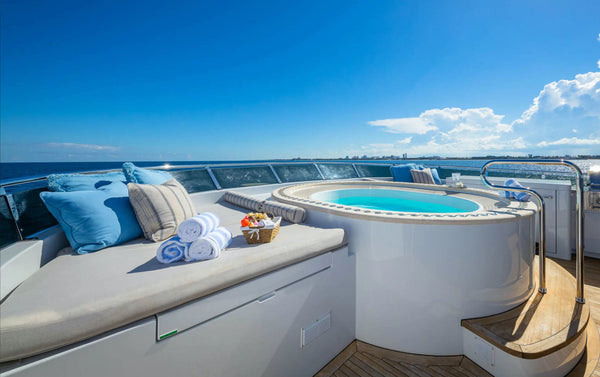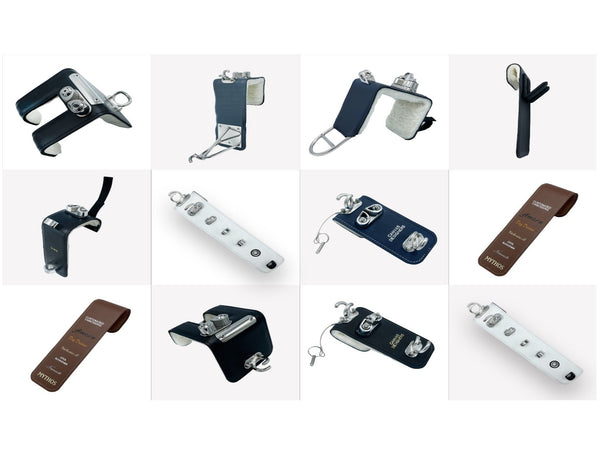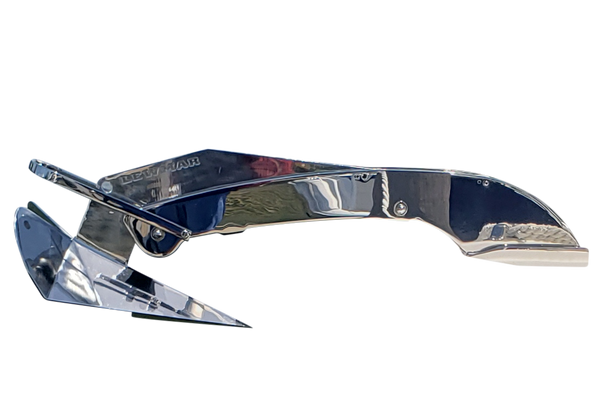marine canvas and upholstery Care & Maintenance
Care and Maintenance
One of the best ways to keep Sunbrella fabrics looking good and to delay deep or vigorous cleanings is to properly maintain the fabrics. This can be accomplished by simply brushing off dirt before it becomes embedded in the fabrics, wiping up spills as soon as they occur or spot cleaning soon after stains occur.
Try this first... With a new spill on your Sunbrella fabric.
• Blot (don’t rub) liquid spills with a clean, dry cloth. For oil-based spills, apply
an absorbent such as corn starch, then remove with a straight edge.
• Spray on a mild cleaning solution of soap (such as Dawn® or Woolite®) and water.
• Rinse the fabric thoroughly to remove all soap residue.
• Air dry.
Try this next... If your first try doesn’t get the spill completely out.
Though Sunbrella fabrics can be used both outdoors and in, your cleaning methods should differ slightly indoors and out because of the fabrication and manufacturing of the furniture.
We recommend using the appropriate cleaning instructions for your application.
Cleaning Removable Fabric
Soak fabric in a solution of 1/4 cup mild soap per gallon of lukewarm water.
Use a sponge or very soft bristle brush to lightly agitate the spill. Then rinse
thoroughly to remove all soap residue, and allow fabric to air dry.
Machine Washing
Some removable casings can be washed in the washing machine, however
consult the furniture manufacturer before removing the casing as cushion
construction may vary. To wash, first close all zippers. Machine wash in cold
water on the delicate cycle with normal amounts of mild laundry detergent.
For severe mold or mildew, add 1 cup of bleach. Allow fabric to air dry.
Prepare a solution of 1/4 cup mild soap per gallon of lukewarm water. Use a
soft bristle brush to clean, allowing the cleaning solution to soak into the fabric.
Rinse thoroughly to remove all soap residue and allow fabric to air dry.
Seam-To-Seam Cleaning
When cleaning upholstered pieces, clean the entire surface area of the fabric, from seam to seam, instead of rubbing the fabric in a circular motion on the spill. This method, along with an extractor, may be required in order to avoid water rings and residue.
Mold and Mildew
Sunbrella fabrics do not promote mildew growth, however, mildew may grow on dirt and other foreign substances if not removed from the fabric. To remove mold or mildew:
• Prepare a solution of 1 cup of bleach and 1/4 cup mild soap per gallon of water.
• Spray on entire area and allow to soak into the fabric for 15 minutes.
• Clean entire surface area with a sponge, clean towel or very soft bristle brush.
• Rinse thoroughly to remove all soap residue.
• Air dry.
For severe mold/mildew growth, bleach quantities may be increased.
It is best to clean the entire surface area of the fabric to avoid water rings and residue.
For other spills, products such as 303
®Multi-Surface Cleaner, Dawn®
• Apply a light mist of mild soap and water using a spray bottle.
• Work the solution into the spill by lightly agitating the entire surface area of the fabric, moving from seam to seam, with a sponge or very soft bristle brush. Avoid scrubbing, and do not use a hard bristled brush or anything that will abrade the
Stamoid® Maintenance
Stamoid® Maintenance
If you want your cockpit covers, Bimini tops, dodgers, seat covers and solar protection screens to keep their initial qualities and looking as good as new, it is essential to follow the cleaning instructions below:
- Stamoid® Marine composite fabrics benefit from the Stamtop® surface treatment which guarantees dirt resistance. As with any other material exposed to the elements, regular maintenance must de done.
- Cleaning should be done according to frequency of use and exposure of the product. We recommend regular cleaning, at least four times a year, to clear out dirt caused by atmospheric pollution.
- Stamoid® Marine composite fabrics should be cleaned as set out in our maintenance notice, see below.
- For wooden boats, in order to avoid any migration risks, it is essential to avoid all contact between the coated side of the fabric and the boat's protective wood varnish.
Care & Maintenance
- Spread the fabric out on a flat surface. Dampen the fabric with clean water. Spray on Ferrari® Clean or add a diluted solution of gentle liquid soap.
- Leave to act for 2 or 3 minutes according to degree of dirt.
- Use a natural bristle brush to brush out to the edges.
- Rinse with a lot of clean water to remove all traces of the soapy solution. If the product comes in contact with other materials, rinse immediately.
- In case of severe dirt and grime, repeat the cleaning process.
- Repeat steps 1 to 5 on the reverse side of the fabric.
- Hang up the Stamoid® Marine textile and leave until completely dry.
- As soon as the textile is completely dry, you can put it back in place to protect your boat.
Care and Cleaning Guide
General care
• Brush off dirt immediately. Allowing it to remain on the cover can result in it getting more deeply embedded into the fabric. Dirt is an organic matter and can provide a habitat for mold and mildew spores to grow.
• Periodically hose down your cover. Rain water can provide rinsing action but often can be a carrier for organic matter as well.
• WeatherMAX is treated with a durable water repellent when it is manufactured. This finish is designed to last for several years but the life span of the repellent can be diminished from several factors such as abrasion, cleaning, chemicals and other atmospheric pollutants. Periodically check to see how well water beads on the fabric. If water drops do not bead but instead flatten and possible soak into the fabric, it is time to retreat the fabric. Cleaning WeatherMAX Fabrics may be spot washed by using a soapy solution of a mild detergent and lukewarm water. Rinse thoroughly with clean water to remove soap and allow to air dry. For mildew stains, prepare a solution of one (1) cup of bleach plus (1/2) cup of mild detergent per gallon of water. Spray on the entire area and allow soaking. Rinse with clean water and allow to air dry
• Be sure to fully rinse the bleach off the fabric
• Protect non-WeatherMAX areas such as sewing thread and reinforcements so the bleach does not come in contact as it may be deteriorate non-WeatherMAX components. After cleaning, check the water repellency of the fabric to see if retreatment might be required. Removing Oil Oil can be effectively removed with an aerosol spot remover. We have found that Pull Out 2 by American Niagara works very well although there are other products available. Retreating WeatherMAX There are several well designed and effective aftermarket water repellent treatments available that work well with WeatherMAX. Follow the directions of the manufacturer.
• Starbrite Waterproofing with PTEF (best overall)
• Formula 303 Fabric Guard (excellent performance but might darken some colors and show folding lines)
• Rust-Oleum NeverWet Outdoor Fabric Spray
• Marlen Aqua-tite
• Kiwi Heavy Duty Water Repellent
Applying 303 High Tech Fabric Guard
303 should be applied to Sunbrella fabrics after each thorough cleaning, which typically removes the original finish and reduces the fabric’s water repellency.
- Clean Sunbrella fabric, using one of the cleaning methods.
- Allow Sunbrella to completely air dry.
- Apply 303 Fabric Guard in a well ventilated area following instructions on the container.
- Apply 303 in a thin, even coat and allow fabric to dry completely.
- Apply a second thin, even coating of 303. (Two light coatings are more effective in restoring fabric water resistance than a single heavy coating. A 15-ounce bottle provides coverage of up to 50 square feet of fabric.)
Helpful hints
Protect the area around the Sunbrella fabric when using a bleach solution – bleach may discolor non-Sunbrella fabrics. Always rinse Sunbrella thoroughly to completely remove bleach.
Please be aware of the environment when cleaning with bleach. Bleach can have harmful effects on the natural environment around you. We do not advise using bleach if you are surrounded by a body of water or other environment that could be affected.
Care and Cleaning Guide and General care for all marine canvas and upholstery products
Care and Cleaning Guide for WeatherMAX Boat Canvas Products
Maintaining your WeatherMAX boat canvas products is essential for ensuring their longevity and effectiveness. Here's a comprehensive guide to help you care for your WeatherMAX fabrics properly:
General Maintenance
Prompt Dirt Removal: It's crucial to brush off any dirt from the canvas promptly. Dirt contains organic materials that can foster mold and mildew growth if not addressed.
Regular Rinsing: Periodically hose down your canvas. While rainwater can help rinse the fabric, it can also introduce organic matter. Regular cleaning helps prevent accumulation.
Durable Water Repellent (DWR) Maintenance: WeatherMAX fabrics are treated with a durable water repellent (DWR) finish during manufacturing. This treatment is designed to last several years but can be affected by abrasion, cleaning, chemicals, and atmospheric pollutants. Periodically check the fabric by sprinkling water on it; if the water no longer beads up, it may be time to reapply a water-repellent treatment.
Cleaning Instructions
Spot Cleaning: For general cleaning, spot-wash WeatherMAX fabrics using mild detergent and lukewarm water. Always rinse thoroughly and allow to air dry.
Mildew Removal: To tackle mildew stains, mix one cup of bleach and half a cup of mild detergent with a gallon of water. Spray this solution onto the affected area, let it soak, then rinse with clean water and air dry. Ensure complete removal of bleach from the fabric to avoid damage.
Protect Non-WeatherMAX Components: When using bleach, shield areas not made of WeatherMAX (like sewing threads and reinforcements) to prevent damage from bleach contact.
Removing Oil Stains
Spot Remover for Oil: Oil stains can be effectively removed with an aerosol spot remover. "Pull Out 2" by American Niagara is highly recommended, though other products may also be effective.
Retreating WeatherMAX Fabrics
Several aftermarket water-repellent treatments work well with WeatherMAX:
Starbrite Waterproofing with PTEF: Offers excellent overall protection.
Formula 303 Fabric Guard: Provides outstanding performance but may darken some colors and highlight folding lines.
Rust-Oleum NeverWet Outdoor Fabric Spray
Marlen Aqua-tite
Kiwi Heavy Duty Water Repellent
For Sunbrella fabrics, specifically, it's advised to apply 303 Fabric Guard after each thorough cleaning. This is because cleaning typically strips the original finish, reducing the fabric's water repellency.
By following these care and cleaning guidelines, you can ensure your WeatherMAX boat canvas remains in top condition, offering protection and beauty for years to come.










